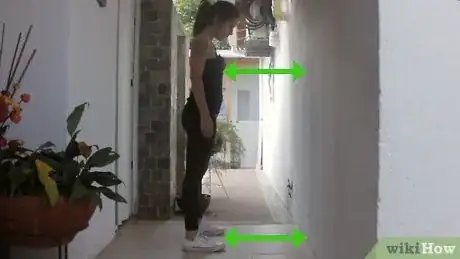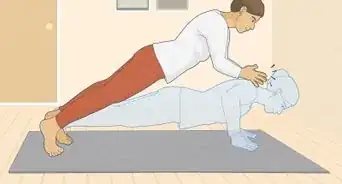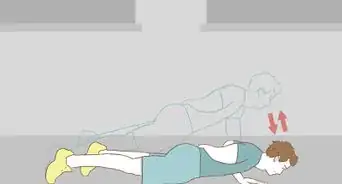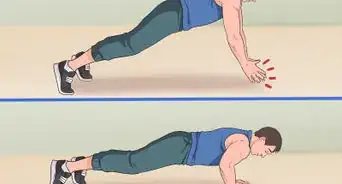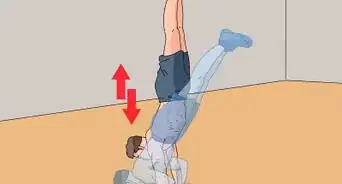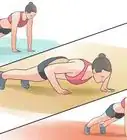This article was co-authored by Adam Shuty. Adam Shuty is a Certified Strength and Conditioning Specialist and owner of ATOMIC Total Fitness, a fitness training studio in New York, New York. With over 15 years of experience, Adam specializes in weightlifting, strength and conditioning, and martial arts. Adam holds a BS in Industrial Engineering from Virginia Polytechnic Institute and State University. In 2014, Adam appeared on the Live With Kelly and Michael Show as one of the top five fitness instructors in the country.
wikiHow marks an article as reader-approved once it receives enough positive feedback. In this case, 100% of readers who voted found the article helpful, earning it our reader-approved status.
This article has been viewed 284,717 times.
Exercising is very important if you want to have and maintain a healthy body. Push ups are an excellent way to strengthen the muscles in your arms, shoulders, and chest, but conventional push ups off the floor are too difficult/strenuous for many people. Using the wall instead of the floor makes it easier to lower and lift yourself, allowing you to build muscle strength without the risk of back pain or falling on the floor. Whether you are pregnant, have arthritis, chronic pain, or just have not toned your muscles enough for standard push ups, doing wall push ups are a great alternative to get you back in shape and feeling your best.
Steps
Doing Wall Push Ups
-
1Get your footing and hand placement. Proper stance and positioning is important for doing a wall push up. If you are too close to the wall, you won't get a proper workout and could potentially hurt your back. If you're too far from the wall, you could risk falling to the floor or hurting your back from arching it uncomfortably.[1] Positioning yourself may require you to lean slightly, so make sure you're ready to perform the wall push up once you're in place.
- While facing the wall, stand just over one arm's length away.
- For most people, a comfortable stance will probably be between 12 to 18 inches (30 to 45 centimeters) away from the wall.[2]
- Your body should create a 45-degree angle when you place your hands against the wall.[3]
- Keep your feet shoulder-width apart.
- Put the palms of both hands flat against the wall at shoulder height, approximately shoulder-width apart.
-
2Lower yourself against the wall. Controlled movements are important in this (or any) form of push up. If you let yourself drop too quickly, you could lose your balance, yet moving too slowly could cause you to get tired out very quickly.
- Keep your feet planted firmly on the floor. Do not lift or shuffle your feet at all while doing push ups.
- Slowly bend your elbows while keeping them at your sides and lower your upper body towards the wall (without hitting yourself against it, of course).
- Lower yourself to a count of four. That is generally a safe span of time in which to drop down during a push up.
- Breathe in while you are lowering yourself. It is much easier to inhale while you are doing the "easier" portion of an exercise motion and to exhale on the strenuous component.
- Keep your back and hips straight as you lower yourself.[4]
- Pause when your chest and/or chin is touching the wall.[5] One or two seconds should be sufficient.
Advertisement -
3Lift yourself back up. Once again, a slow and well-controlled motion is crucial during wall push ups, and that includes when you are lifting yourself back up. Do not hurry or you could hurt your back, shoulders, or elbows.
- Exhale as you begin to push off the wall and hold your elbows in at your sides.
- Lift yourself up to a count of two. You should not need as much time as you took lowering yourself since there is not as much risk of hitting the wall while returning to your start position.
- Continue to keep your feet firmly planted with your back and hips straight throughout the push up.[6]
- The push up is complete when you have completely returned to your starting position. Make sure that you do not lock your elbows once your arms are fully extended or you could injure yourself.
-
4Repeat. By now, you have completed a wall push up with the proper form and positioning. But you will not build any muscle by doing one single push up! It's important to work out in sets with a predetermined number of repetitions per set in order to get the most out of your workout.
- 10 to 15 push ups is a good number of repetitions in a given set.
- Rest for one or two minutes after finishing your first set. Then, if you're able to, try to do another set of 10 to 15 push ups.
Making Your Workout More Challenging
-
1Gauge your progress. Doing wall push ups is a great way to strengthen your pectoral and tricep muscles.[7] However, just because you can do a few sets of wall push ups, it doesn't necessarily mean you should move to the floor just yet.
- It takes time and consistent effort to build muscle mass.
- By some accounts, it can take anywhere from six weeks to six months before you build any noticeable muscle mass.[8]
- Make sure you have adequately built some muscle before trying to advance your workout routine into anything more challenging.
-
2Progress to a lower surface. Once you have built some muscle from doing wall push ups and can comfortably do multiple sets, you may want to progress to something more challenging. Before you tackle traditional push ups on the floor, it's a good idea to work your way down to lower and lower levels (and build more muscle mass in the process).[9]
- First, try doing push ups off of a counter ledge. It's slightly lower than a shoulder-height spot on the wall, but still easy enough to execute the movements without much difficulty.
- Progress to a couch armrest. The armrest of a couch will be slightly lower still than the counter. Just make sure your couch is sturdy - have someone sit on the opposite end if there is any risk of the couch flipping over on you.
- You can also try practicing on the first or second step on a set of stairs.
- Finally, after several weeks of training at each incremental height, you may be ready to try the floor. Doing a regular push up off the floor is difficult though, so make sure you are prepared for it.
- There is no objective measure of when you are prepared to advance your workout. Only you can decide when wall push ups (and each subsequently lower surface) become easy enough to do comfortably.
-
3Consider doing bench presses. Eventually, after many weeks or months of doing different types of push ups, your workout routine may hit a wall. As you get stronger and build up more and more muscle mass, push ups (off of any surface) won't offer you enough of a challenge. When this happens, you may want to consider a weight-lifting regimen like bench presses.[10]
- Bench presses work many of the same muscles as push ups, but have the added benefit that you can add more weight on once your current routine becomes too comfortable.
- Remember that it's important to measure your progress and decide for yourself whether or not you are ready and able to advance your training to something more challenging.
- Have someone you trust who is able to lift weights supervise (or "spot") you while you lift weights. That way, if anything goes wrong or if you can't lift the weights, your friend or gym buddy will be able to help you get the weights back on the rack.
Expert Q&A
Did you know you can get expert answers for this article?
Unlock expert answers by supporting wikiHow
-
QuestionWhat should I stand while doing wall push-ups?
 Adam ShutyAdam Shuty is a Certified Strength and Conditioning Specialist and owner of ATOMIC Total Fitness, a fitness training studio in New York, New York. With over 15 years of experience, Adam specializes in weightlifting, strength and conditioning, and martial arts. Adam holds a BS in Industrial Engineering from Virginia Polytechnic Institute and State University. In 2014, Adam appeared on the Live With Kelly and Michael Show as one of the top five fitness instructors in the country.
Adam ShutyAdam Shuty is a Certified Strength and Conditioning Specialist and owner of ATOMIC Total Fitness, a fitness training studio in New York, New York. With over 15 years of experience, Adam specializes in weightlifting, strength and conditioning, and martial arts. Adam holds a BS in Industrial Engineering from Virginia Polytechnic Institute and State University. In 2014, Adam appeared on the Live With Kelly and Michael Show as one of the top five fitness instructors in the country.
Certified Strength & Conditioning Specialist
wikiHow Video: How to Do a Wall Push Up
Warnings
- Start slowly. Build up speed as you go along in a comfortable rhythm.⧼thumbs_response⧽
- Talk to your doctor before beginning this or any other workout regimen. Do not attempt to do any type of push ups if you suffer from a medical condition without first getting medical clearance.⧼thumbs_response⧽
References
- ↑ Adam Shuty. Certified Strength & Conditioning Specialist. Expert Interview. 26 August 2020.
- ↑ http://www.webmd.com/fitness-exercise/scapular-exercise-wall-push-ups
- ↑ Adam Shuty. Certified Strength & Conditioning Specialist. Expert Interview. 26 August 2020.
- ↑ Adam Shuty. Certified Strength & Conditioning Specialist. Expert Interview. 26 August 2020.
- ↑ http://www.mayoclinic.org/healthy-lifestyle/pregnancy-week-by-week/multimedia/pregnancy-exercises/sls-20076779
- ↑ http://www.webmd.com/fitness-exercise/scapular-exercise-wall-push-ups
- ↑ http://www.mayoclinic.org/healthy-lifestyle/pregnancy-week-by-week/multimedia/pregnancy-exercises/sls-20076779
- ↑ https://blog.udemy.com/how-long-does-it-take-to-build-muscle/
- ↑ http://www.webmd.com/fitness-exercise/scapular-exercise-wall-push-ups
- ↑ http://www.webmd.com/men/features/strength-training-building-arm-muscles?page=2
- ↑ Adam Shuty. Certified Strength & Conditioning Specialist. Expert Interview. 26 August 2020.
- https://www.youtube.com/watch?v=a6YHbXD2XlU
About This Article
Wall pushups are a great way to strengthen your upper body without putting as much strain on your back as a traditional floor pushup. To do a wall pushup, start by finding a wide, straight wall where you won’t be up against any corners or other obstacles. Stand just a little over an arm’s length away from the wall with your shoulders square and your feet shoulder-width apart. You should be far enough from the wall that you have to lean forward slightly to put your hands against it, with your body tilted at a 45° angle. Place both hands on the wall in front of you, with your hands and elbows lined up with your shoulders. Keep your elbows straight, but be careful not to lock them, since this can be hard on your joints. Then, gradually bend your elbows until your upper body is up against the wall. Do this in a slow, controlled motion and keep your feet locked in place so that you don’t lose your balance. Try to keep your back, hips, and legs in a straight line the whole time. As you lower yourself against the wall, gradually breathe in. It might help to slowly count to 4 in your head as you lean in. Pause for 1 or 2 seconds with your chest and chin against the wall, then carefully push back away from the wall. Exhale and slowly count to 2 as you straighten your elbows. Once you’ve returned to your starting position, the pushup is complete. Aim to do 2 sets of 10 to 15 pushups, and rest for 1 or 2 minutes between sets. As you get more comfortable doing wall pushups, boost the difficulty level of your workout by pushing up from a lower surface. For instance, try pushing up from a tabletop, the armrest of a couch, or even the bottom step on a staircase. After a few weeks of doing pushups at lower and lower heights, you may be ready to switch to regular floor pushups. Just take it slow, and don’t do anything you’re not comfortable with. For more tips from our Personal Training reviewer, including how to make wall push ups more challenging, keep reading!
